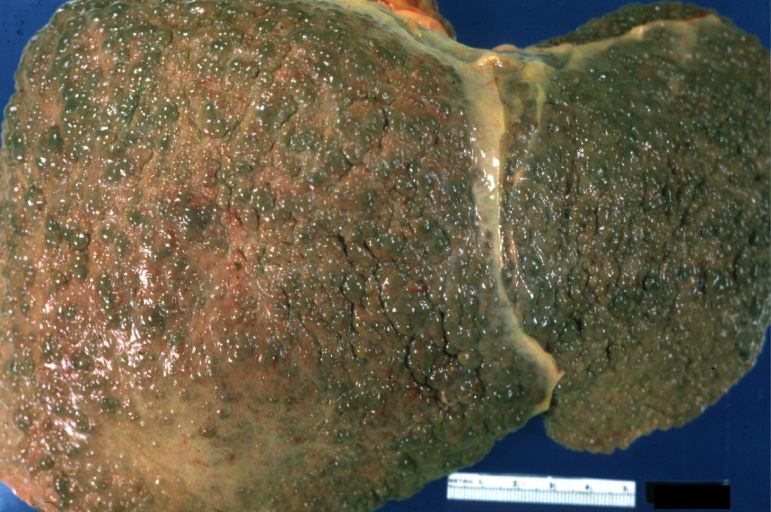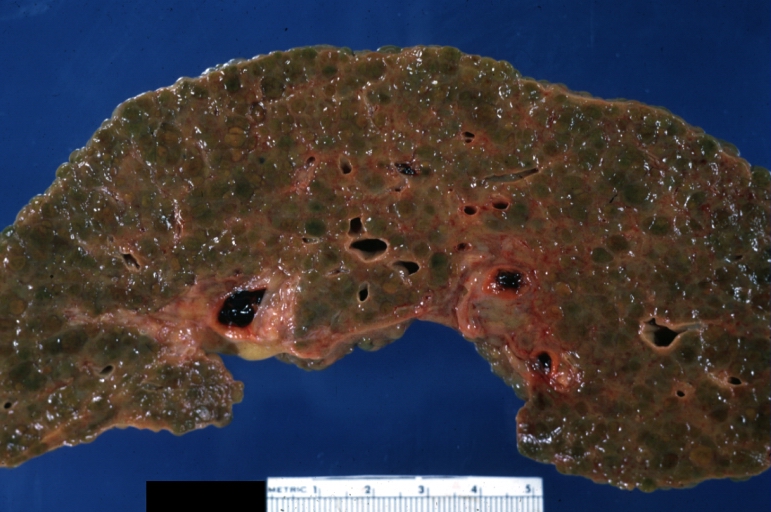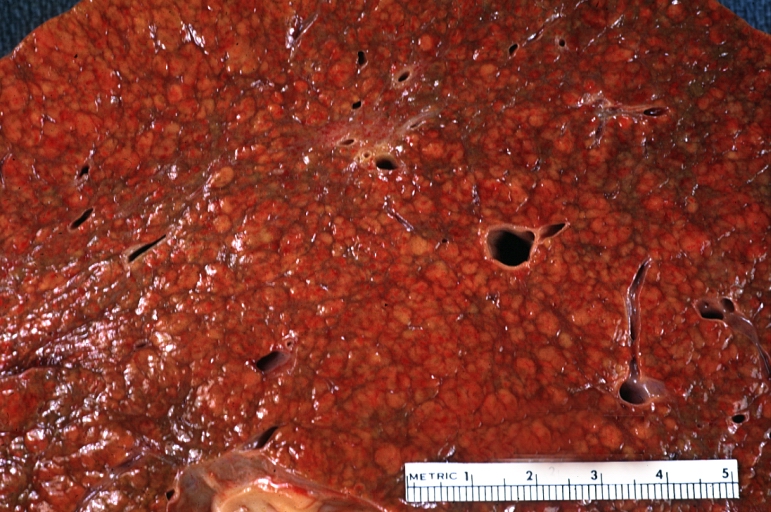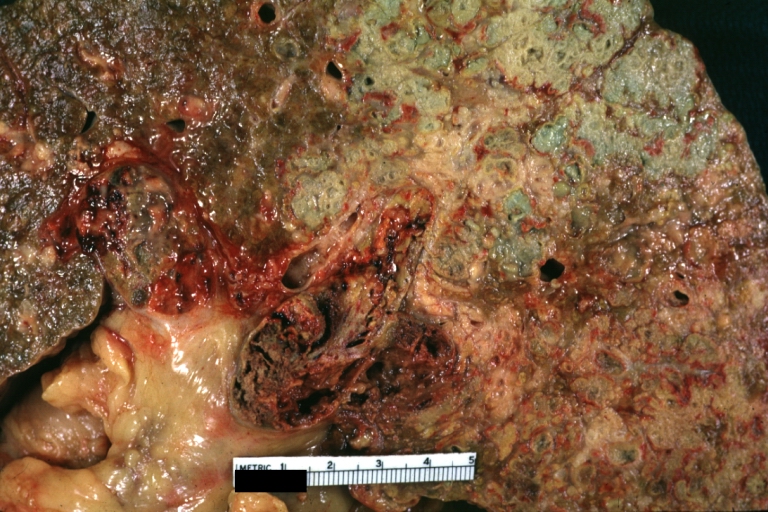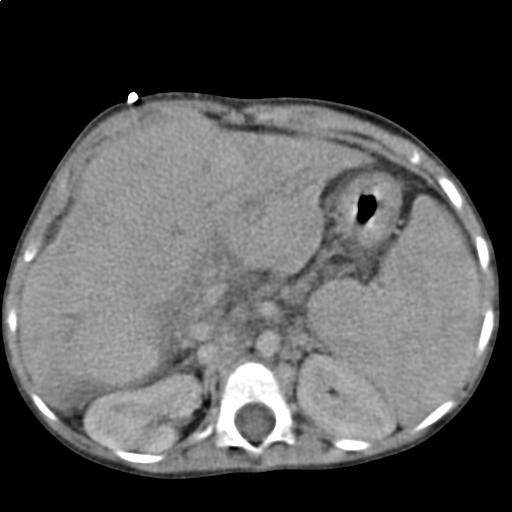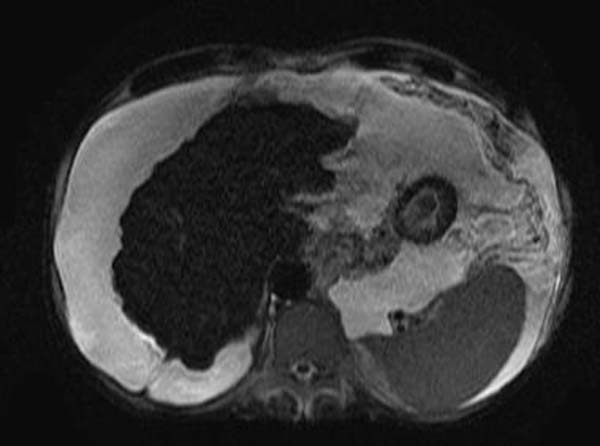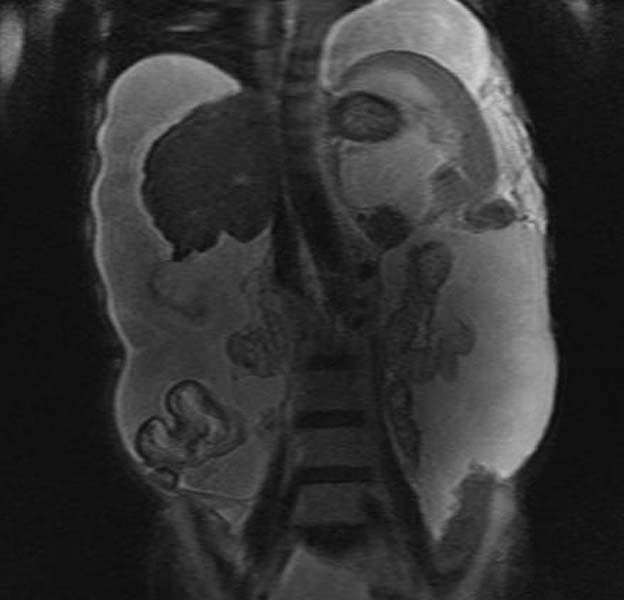Cirrhosis (patient information): Difference between revisions
| Line 22: | Line 22: | ||
==What is cirrhosis?== | ==What is cirrhosis?== | ||
<gallery> | |||
Image:Cirrhosis 001.jpg|Cirrhosis: Gross, external view of micronodular cirrhosis | |||
Image:Cirrhosis 002.jpg|Cirrhosis: Gross, cut section of previous one (an excellent example) | |||
Image:Cirrhosis 003.jpg|Cirrhosis: Gross, close-up image | |||
Image:Cirrhosis 004.jpg|Macronodular cirrhosis and hepatoma | |||
</gallery> | |||
[[Liver]] is a large organ that locates in the upper abdomen, carring out several essential functions, such as detoxifying harmful substances in the body, purifying blood and manufacturing vital nutrients. Cirrhosis occurs in response to chronic damage to your liver for several years. A number of diseases and conditions can cause the chronic liver damage that leads to cirrhosis. Chronic [[alcohol abuse]] is the most common cause of cirrhosis in the United States and other western countries. And chronic [[hepatitis]] B and C viruses are the most common cause in some Asian countries. Early cirrhosis does not have any symptoms. With the disease developing, the patient may experience symptoms such as [[fatigue]] and [[weakness]], [[loss of appetite]], [[nausea]] and [[vomiting]], [[weight loss]], [[abdominal pain]] and [[abdominal bloating]], [[itching]], [[jaundice]], even [[gastrointestinal bleeding]]. Blood tests, imaging procedures and liver [[biopsy]] may help diagnose. The goals of treatment of cirrhosis are to slow the progression of scar tissue in the liver and prevent or treat the [[complication]]s of the disease. Treatment options depend on the underling cause and whether complications are present. Usual treatments include medications and liver transplant surgery. The prognosis of cirrhosis depends on whether [[complication]]s are present and liver function. | [[Liver]] is a large organ that locates in the upper abdomen, carring out several essential functions, such as detoxifying harmful substances in the body, purifying blood and manufacturing vital nutrients. Cirrhosis occurs in response to chronic damage to your liver for several years. A number of diseases and conditions can cause the chronic liver damage that leads to cirrhosis. Chronic [[alcohol abuse]] is the most common cause of cirrhosis in the United States and other western countries. And chronic [[hepatitis]] B and C viruses are the most common cause in some Asian countries. Early cirrhosis does not have any symptoms. With the disease developing, the patient may experience symptoms such as [[fatigue]] and [[weakness]], [[loss of appetite]], [[nausea]] and [[vomiting]], [[weight loss]], [[abdominal pain]] and [[abdominal bloating]], [[itching]], [[jaundice]], even [[gastrointestinal bleeding]]. Blood tests, imaging procedures and liver [[biopsy]] may help diagnose. The goals of treatment of cirrhosis are to slow the progression of scar tissue in the liver and prevent or treat the [[complication]]s of the disease. Treatment options depend on the underling cause and whether complications are present. Usual treatments include medications and liver transplant surgery. The prognosis of cirrhosis depends on whether [[complication]]s are present and liver function. | ||
Revision as of 16:28, 25 February 2010
For the WikiDoc page for this topic, click here
| Cirrhosis (patient information) | |
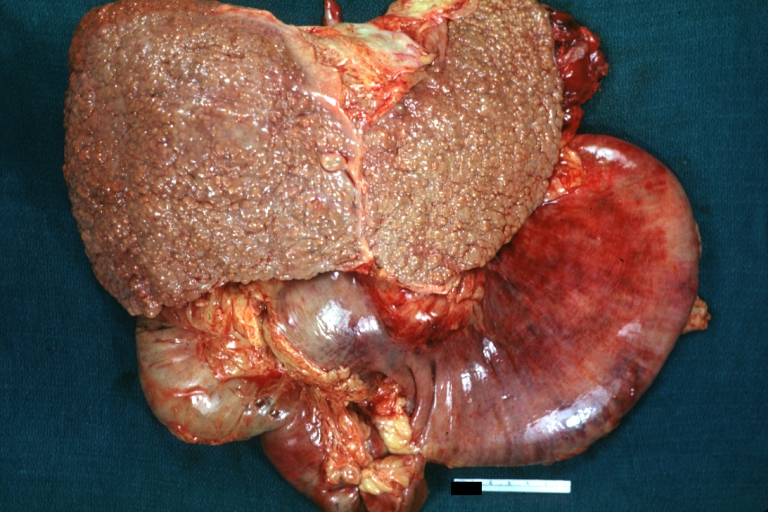 | |
|---|---|
| Gross, natural color of liver and stomach view from external surfaces, micronodular cirrhosis and hemorrhagic gastritis (as the surgeon would see these in natural color). Image courtesy of Professor Peter Anderson DVM PhD and published with permission © PEIR, University of Alabama at Birmingham, Department of Pathology | |
| ICD-10 | K70.3, K71.7, K74 |
| ICD-9 | 571 |
| DiseasesDB | 2729 |
| eMedicine | med/3183 radio/175 |
| MeSH | D008103 |
Editor-In-Chief: C. Michael Gibson, M.S., M.D. [1]; Jinhui Wu, MD
Please Join in Editing This Page and Apply to be an Editor-In-Chief for this topic: There can be one or more than one Editor-In-Chief. You may also apply to be an Associate Editor-In-Chief of one of the subtopics below. Please mail us [2] to indicate your interest in serving either as an Editor-In-Chief of the entire topic or as an Associate Editor-In-Chief for a subtopic. Please be sure to attach your CV and or biographical sketch.
What is cirrhosis?
-
Cirrhosis: Gross, external view of micronodular cirrhosis
-
Cirrhosis: Gross, cut section of previous one (an excellent example)
-
Cirrhosis: Gross, close-up image
-
Macronodular cirrhosis and hepatoma
Liver is a large organ that locates in the upper abdomen, carring out several essential functions, such as detoxifying harmful substances in the body, purifying blood and manufacturing vital nutrients. Cirrhosis occurs in response to chronic damage to your liver for several years. A number of diseases and conditions can cause the chronic liver damage that leads to cirrhosis. Chronic alcohol abuse is the most common cause of cirrhosis in the United States and other western countries. And chronic hepatitis B and C viruses are the most common cause in some Asian countries. Early cirrhosis does not have any symptoms. With the disease developing, the patient may experience symptoms such as fatigue and weakness, loss of appetite, nausea and vomiting, weight loss, abdominal pain and abdominal bloating, itching, jaundice, even gastrointestinal bleeding. Blood tests, imaging procedures and liver biopsy may help diagnose. The goals of treatment of cirrhosis are to slow the progression of scar tissue in the liver and prevent or treat the complications of the disease. Treatment options depend on the underling cause and whether complications are present. Usual treatments include medications and liver transplant surgery. The prognosis of cirrhosis depends on whether complications are present and liver function.
How do I know if I have cirrhosis and what are the symptoms of cirrhosis?
Early cirrhosis does not have any symptoms. However, as the disease progresses, a person may experience the following symptoms:
- Fatigue and weakness
- Loss of appetite
- Nausea and vomiting
- Weight loss
- Abdominal pain and bloating when fluid accumulates in the abdomen
- Itching
- Bleeding easily, even gastrointestinal bleeding
- Jaundice
- Spider angiomata
- Confusion
Other health problems may also cause these symptoms. Only a doctor can tell for sure. A person with any of these symptoms should tell the doctor so that the problems can be diagnosed and treated as early as possible.
Who is at risk for cirrhosis?
Cirrhosis can be caused by many things, some known and others unknown:
- Chronic alcohol abuse: This is the most common cause of cirrhosis in the United States and other western countries.
- Chronic Hepatitis B and C viruses and perhaps other viruses, can damage the liver over a prolonged time and eventually cause cirrhosis. This is the most common cause of cirrhosis in some Asian countries.
- Autoimmune hepatitis: The body's protective antibodies injure the liver cells because they fail to recognize the liver as its own tissue.
- Chronic bile duct blockage
- Wilson's Disease or hemochromatosis: Tetals are present in all body cells. When abnormal amounts of them accumulate in the liver, scarring and cirrhosis may develop.
- Cystic fibrosis and Alpha l-antitrypsin deficiency
- Nonalcoholic fatty liver disease
- Drugs and toxins: Studies demonstrate that prolonged exposure to certain chemicals or drugs can damage the liver.
How to know you have cirrhosis?
- Blood tests: Blood tests such as a complete blood count, bilirubin test, coagulation study and liver function tests to determine the cause of cirrhosis, and assess liver function and coagulation function.
- Imaging procedures and liver biopsy: Images studies such as ultrasound, computerized tomography (CT), and magnetic resonance imaging (MRI) can show the constructure of liver and organs nearby. These images tests can also be used to guide biopsy and a biopsy sample is usually removed and looked at under a microscope by a pathologist. Liver biopsy can tell valuable information about the disease.
-
Liver cirrhosis as seen on an axial CT of the abdomen.
-
T2
-
T2
When to seek urgent medical care?
Call your health care provider if symptoms of cirrhosis develop. If you experience either of the following symptoms, seeking urgent medical care as soon as possible:
Treatment options
The goals of treatment of cirrhosis are to slow the progression of scar tissue in the liver and prevent or treat the complications of the disease. Treatment options depend on the underling cause and whether complications are present. Hospitalization may be necessary for cirrhosis with complications.
- Diet: Eating a nutritious diet is very important in all stages of cirrhosis. To improve nutrition, sometimes the doctor may add a liquid supplement taken by mouth or through a nasogastric tube. If ascites develops, a sodium-restricted diet is recommended.
- Treatments on the specific causes of cirrhosis: Interferon and other antiviral drugs may be prescribed for viral hepatitis, and autoimmune hepatitis requires corticosteroids and other drugs that suppress the immune system.
- Avoiding alcohol: The alcoholic patient must permanently stop consuming alcohol.
- Edema and ascites: For edema and ascites, diuretics will be recommended to remove fluid from the body. Large amounts of ascitic fluid may be removed from the abdomen and checked for bacterial peritonitis.
- Infections: Oral antibiotics may be prescribed to prevent infection. Severe infection with ascites will require intravenous antibiotics.
- Portal hypertension: The doctor may prescribe a beta-blocker or nitrate to control portal hypertension and reduce the risk of bleeding.
- Gastrointestinal bleeding: This severe complication requires an immediate upper endoscopy to look for esophageal varices and to compress the varices to stop the bleeding. People who have had varices in the past may need to take medicine to prevent future episodes.
- Hepatic encephalopathy: At first, the patient may be asked to reduce dietary protein intake. Then, lactulose may be prescribed by oral or in enemas to cleanse the bowel. If necessary, antibiotics are added to the treatment.
- Hepatorenal failure: These patients must undergo regular hemodialysis treatment to improve blood flow through the kidneys.
- Symptomatic treatment: Medications are given to treat various symptoms of cirrhosis, such as itching and constipation.
- Liver transplant surgery: Patients with advanced cirrhosis may require liver transplants if they have liver failure. Liver transplant is a procedure to remove your liver and replace it with a whole liver from a deceased donor or with part of a liver from a living donor.
Diseases with similar symptoms
Where to find medical care for cirrhosis?
Directions to Hospitals Treating cirrhosis
Prevention of cirrhosis
- Avoidance of alcohol abuse
- Vaccine for hepatitis B virus
- Eat a healthy diet and maintain a healthy weight
What to expect (Outook/Prognosis)?
The prognosis of cirrhosis depends on:
- Whether complications, such as ascites and gastrointestinal bleeding, are present.
- Liver function
Copyleft Sources
http://digestive.niddk.nih.gov/ddiseases/pubs/cirrhosis/index.htm
http://www.mayoclinic.com/print/cirrhosis/DS00373/DSECTION=all&METHOD=print
http://www.hepatitis.va.gov/vahep?page=cirrh-00-00
